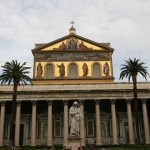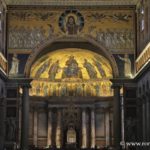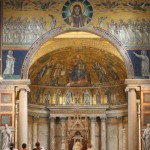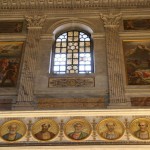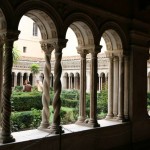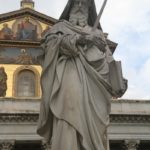In Italian: Basilica di San Paolo fuori le mura
The Basilica of Saint Paul Outside the Walls, located beyond the Aurelian Walls in Rome, is a major basilica founded in the 5th century and faithfully rebuilt after a fire in 1823. This grand edifice is renowned for its unique frieze of 265 medallions depicting all the popes and preserves a well-maintained 13th-century Cosmati cloister.
The visit to the Basilica of Saint Paul Outside the Walls ranks 25th in the Top 30 Things to See in Rome.
Overview and History of the Basilica of Saint Paul Outside the Walls
History and Evolution
The basilica was founded under Emperor Theodosius I in 386 on the site of an earlier church built above the tomb of the Apostle Paul, who was beheaded under Nero between 64 and 67 AD. Designed with a five-nave layout, it originally measured 131 meters long, 65 meters wide, and 30 meters high, surpassing the size of the old Saint Peter’s Basilica. This 4th-5th century masterpiece, located outside the Aurelian Walls south of Rome, was expanded under Emperors Valentinian II and Honorius before its consecration in 395.
A devastating fire, caused by a careless worker on July 15, 1823, nearly destroyed the building. The reconstruction, completed in 1854 under architect Luigi Poletti, preserved the original layout thanks to international donations, including precious stones from Tsar Nicholas I for the decorations. This monumental project reflects the determination to safeguard the historical and spiritual legacy of this sacred site.
The Basilica: Architecture and Treasures
The vast, luminous interior rests on 80 monolithic white marble columns, dividing the naves and supporting a gilded coffered ceiling. The walls are adorned with panels illustrating scenes from the Gospel, drawn from the Acts of the Apostles and Paul’s epistles. An exceptional frieze, over 200 meters long, runs above the columns and features 265 mosaic medallions, each depicting a pope from Saint Peter to modern pontiffs, with spaces reserved for future successors. Beneath the triumphal arch, a 5th-century mosaic commissioned by Empress Galla Placidia and restored after the fire portrays an apocalyptic vision of Christ in majesty, surrounded by angels and symbols of the evangelists.
The Cosmati cloister, built between 1205 and 1241 by the Vassalletto family, survived the flames. This 36-square-meter gem, adorned with twisted columns and polychrome mosaics, houses fragments of the original basilica, Roman sarcophagi, and medieval inscriptions. An architectural curiosity lies in the main altar, positioned directly above the tomb of Saint Paul, excavated in 2006, where analyses confirmed a 4th-century sarcophagus containing human remains. The 19th-century bell tower, rising 46 meters, contrasts with the site’s antiquity. Listed as a UNESCO World Heritage Site alongside Rome’s other major basilicas, Saint Paul Outside the Walls remains a pilgrimage destination and a testament to the evolution of Christian art.
Hours, Practical Information, and Map
Basilica di San Paolo fuori le mura
Piazzale di San Paolo, 1 – Rome
- Basilica: 7:00 AM – 6:30 PM
- Cloister and Pinacoteca
Open daily from 8:30 AM to 6:00 PM, admission €4.00. For groups of 10 or more: €2.00 per person
Online Resources
- Official website: basilicasanpaolo.org
- The Basilica of Saint Paul Outside the Walls on rome-roma.net, photos, history, and architecture
- Info and hours on the 060608 municipal site
- Wikipedia page
Address, Map, and How to Reach Saint Paul
The basilica is located outside Rome’s walls, south of the city center. The fastest way to reach it is via Metro Line B to the Basilica San Paolo station (15 minutes from Termini, for example), just a 5-minute walk away.
By bus, lines 23, 170, and 769 stop near the entrance.
Address: Piazzale di San Paolo, 1 – Rome
If you see this after your page is loaded completely, leafletJS files are missing.
Accommodations Near Saint Paul Outside the Walls
Selection of accommodations near the basilica:
- Top hotels and accommodations sorted BY PRICE (2 adults) within 1000 meters of Saint Paul
- Top hotels and accommodations sorted BY DISTANCE from Saint Paul
Photo Gallery of the Basilica of Saint Paul
- St. Paul Outside the Walls
- Outside, in front
- Central nave
- Apse
- Mosaic of the apse
- Apse
- St. Paul Outside the Walls
- Cloister
- Statue de Saint-Paul
FAQ and Visiting Tips
Can you attend a Mass in the basilica?
Yes, Masses are held daily, typically in the morning around 7:30 or 8:00 AM, and on Sundays at 10:30 AM. Schedules may vary depending on the season or religious holidays, such as the feast of Saint Paul on June 29, which features a special celebration attracting many pilgrims.
What is the connection between the basilica and Via Ostiense?
The basilica is located near the Via Ostiense, an ancient Roman road connecting Rome to the port of Ostia.
Has the basilica influenced other constructions?
Yes, its five-nave layout and grand proportions inspired medieval churches, such as Lisbon Cathedral in the 12th century. Its architectural style also influenced the reconstruction of Romanesque basilicas after similar disasters.
What can you visit on foot near the basilica?
Nearby, you can explore the fascinating Testaccio district and the Aventine Hill with Santa Sabina and the Orange Garden, offering a beautiful terrace with city views. Notable sites also include the Protestant Cemetery and the Pyramid of Caius Cestius near Porta San Paolo.








